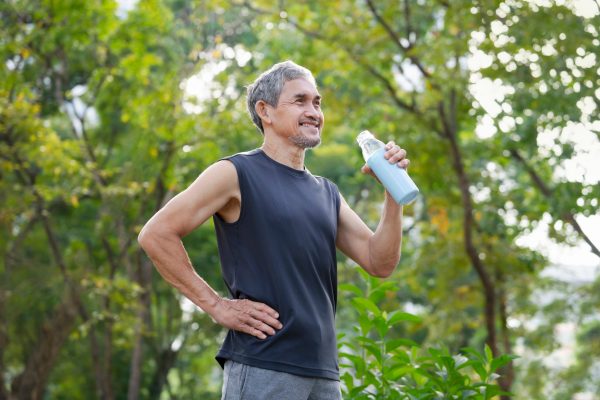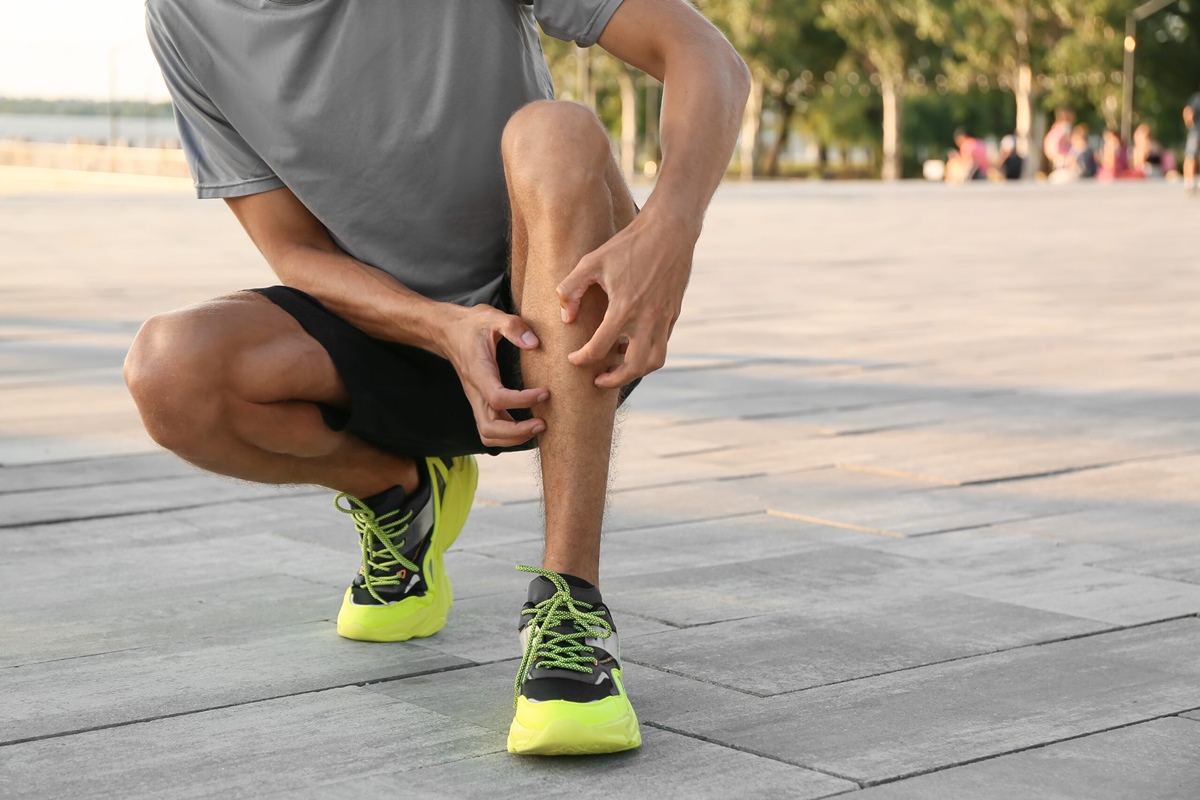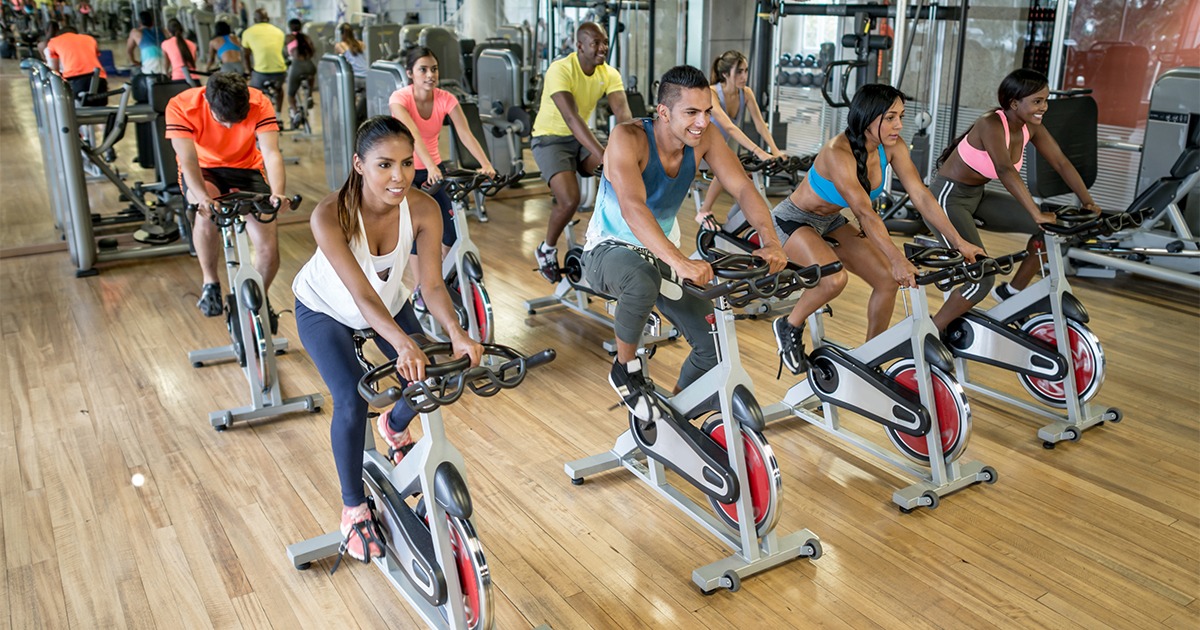Home>Misc>Featured>How Is Perspiration Related To Recovery After Exercise?


Featured
How Is Perspiration Related To Recovery After Exercise?
Published: September 27, 2023
Discover how perspiration is directly linked to the recovery process after exercise in our featured article. Learn more about its benefits and how to optimize your post-workout sweat.
Introduction
Welcome to the world of exercise and recovery! If you’ve ever engaged in physical activity, you’ve likely experienced the rise of perspiration, commonly known as sweat. While sweat may seem like an inconvenience, it actually plays a critical role in the body’s ability to recover after exercise. Understanding the relationship between perspiration and recovery is key to optimizing your post-workout routine.
When we exercise, our bodies generate heat as a result of increased metabolic activity. Perspiration is the body’s natural response to help regulate temperature and prevent overheating. As sweat evaporates from the skin’s surface, it cools the body down, enabling us to continue exercising without succumbing to heat-related ailments.
However, perspiration involves more than just cooling. It also allows for the elimination of toxins and metabolic waste products from the body. Additionally, sweat contains electrolytes, minerals essential for various bodily functions. Understanding the impact of sweat loss, electrolyte imbalance, and fluid replenishment on recovery is crucial for athletes and fitness enthusiasts alike.
In this comprehensive guide, we will explore the fascinating relationship between perspiration and recovery after exercise. We will delve into the mechanisms of perspiration, explore the impact of fluid and electrolyte loss during physical activity, and examine how the body uses sweat to cool down. Furthermore, we will discuss the role of sweat rate and composition in the recovery process, explore the significance of rehydration, and highlight strategies to optimize perspiration and recovery.
Whether you’re a seasoned athlete aiming to improve your performance or a casual gym-goer looking to enhance your post-workout routine, understanding the link between perspiration and recovery will help you make informed choices to support your body’s healing process. So, let’s dive in and uncover the secrets behind the fascinating world of perspiration and post-exercise recovery!
The Mechanism of Perspiration
Perspiration is a complex physiological process that involves the activation of sweat glands in the skin. These sweat glands, known as eccrine glands, are distributed all over the body, with the highest concentration in the palms, soles of the feet, and forehead.
The process of perspiration begins when the body’s thermoregulatory system detects an increase in internal body temperature. The hypothalamus, a region in the brain responsible for regulating body temperature, sends signals to the sweat glands to start producing sweat.
Within the sweat glands, cell clusters called secretory coils collect water, electrolytes, and other substances from the surrounding blood vessels. As the sweat moves through the sweat ducts, located within the dermis (the middle layer of the skin), it undergoes modifications to maintain an optimal composition.
When sweat reaches the skin’s surface, it is released through tiny openings called sweat pores. As the sweat evaporates, it extracts heat from the body, cooling it down and preventing overheating.
The composition of sweat varies depending on factors such as genetics, fitness level, diet, and environmental conditions. Generally, sweat is made up of water, sodium chloride (salt), potassium, calcium, magnesium, and small traces of other minerals and waste products.
It’s important to note that perspiration is not solely a response to physical activity or high temperatures. Emotional stress, anxiety, and hormonal changes can also trigger the sweat glands, leading to perspiration.
In addition to eccrine glands, the body also has apocrine glands, which are concentrated in the armpits, groin, and other hairy areas. Unlike eccrine glands that produce sweat, apocrine glands release a different type of secretion that interacts with bacteria on the skin’s surface, resulting in body odor.
Understanding the mechanism of perspiration allows us to appreciate its vital role in maintaining a stable body temperature and facilitating recovery after exercise. The next sections will explore the specific impacts of perspiration on fluid loss, cooling, and the post-exercise recovery process.
Loss of Fluids and Electrolytes during Exercise
When we engage in physical activity, especially intense or prolonged exercise, our bodies work hard to generate energy and maintain optimal performance. One consequence of this heightened activity is the loss of fluids and electrolytes through perspiration.
Fluid loss occurs primarily through the process of sweat evaporation from the skin. The amount of fluid lost can vary depending on factors such as exercise intensity, duration, environmental conditions, and individual characteristics like body size and fitness level.
Electrolytes, on the other hand, are essential minerals that play crucial roles in various bodily functions, including muscle contraction, nerve signaling, and maintaining fluid balance. Common electrolytes found in sweat include sodium, potassium, calcium, and magnesium.
During exercise, the loss of fluids and electrolytes can have significant implications for the body’s functioning. Dehydration, which occurs when fluid loss exceeds fluid intake, can lead to reduced exercise performance, muscle cramps, fatigue, and even heat-related illnesses.
Moreover, electrolyte imbalances resulting from excessive sweat loss can disrupt cellular processes and hinder muscle function. Sodium, in particular, plays a critical role in maintaining proper fluid balance and ensuring optimal muscle and nerve function.
To mitigate the negative effects of fluid and electrolyte loss during exercise, it is essential to replenish fluids and electrolytes through adequate hydration strategies. Drinking water alone may not be sufficient, as sweat contains more than just water. Including sources of electrolytes, such as sports drinks or electrolyte-enhanced water, can help restore the body’s electrolyte balance.
It’s worth noting that drinking excessive amounts of water without replacing electrolytes can also lead to an imbalance, known as hyponatremia, where sodium levels in the body become dangerously low. Therefore, finding the right balance of hydration and electrolyte replenishment is crucial for maintaining optimal performance and supporting post-exercise recovery.
In the following sections, we will delve deeper into the role of perspiration as a cooling mechanism and its implications for post-exercise recovery. Understanding the relationship between perspiration, hydration, and electrolyte balance is essential for optimizing recovery strategies and promoting overall well-being.
Perspiration as a Cooling Mechanism
Perspiration, or sweat, serves as a vital cooling mechanism for the body during exercise and physical exertion. As the sweat evaporates from the skin’s surface, it dissipates heat and cools down the body, preventing overheating and allowing for prolonged periods of activity.
When we exercise, our bodies generate heat as a result of increased metabolic activity. This heat must be dissipated to maintain a stable internal body temperature. Perspiration plays a crucial role in this process, as it allows for the transfer of heat from the body to the environment.
The evaporation of sweat is an energy-intensive process that consumes heat energy from the body. As sweat glands produce sweat, it is secreted onto the skin’s surface, creating a moist layer. When this moisture comes into contact with ambient air, the heat energy is transferred to the water molecules, causing them to evaporate.
This evaporation process cools the skin and underlying tissues, effectively lowering the body’s temperature. The cooled blood then circulates back into the body, regulating the internal temperature and allowing for continued physical activity without risk of overheating.
The amount of perspiration produced during exercise can vary depending on several factors, including exercise intensity, duration, environmental conditions, and individual factors such as fitness level and genetics.
High-intensity or prolonged exercise generally leads to increased perspiration to dissipate the higher levels of heat generated. Additionally, exercising in hot and humid environments can exacerbate sweat production due to the reduced rate of sweat evaporation.
It’s important to note that the cooling effect of perspiration may be influenced by other factors such as clothing, humidity, and air circulation. Wearing breathable and moisture-wicking fabrics can help facilitate sweat evaporation and enhance the cooling process.
Understanding perspiration as a cooling mechanism is essential for athletes and fitness enthusiasts alike. By recognizing the importance of sweat in regulating body temperature, individuals can make informed decisions about their exercise routines, clothing choices, and hydration strategies to optimize performance and prevent overheating.
In the next section, we will explore how perspiration relates to post-exercise recovery and discuss the role of sweat rate and composition in the recovery process.
Perspiration and Post-Exercise Recovery
Perspiration not only plays a role in cooling the body during exercise but also has implications for the post-exercise recovery process. Recovery after exercise is essential to allow the body to repair, rebuild, and adapt to the physical stress placed upon it.
One aspect of post-exercise recovery is the removal of metabolic waste products and toxins from the body. Perspiration aids in this process by eliminating these waste products through sweat. As the body cools down, the sweat glands continue to produce sweat, carrying away metabolic byproducts such as lactic acid and urea.
Moreover, perspiration helps to restore the body’s fluid balance after exercise-induced fluid loss. When we sweat, we lose water and electrolytes, which are vital for proper functioning of muscles, nerves, and organs. Replenishing these lost fluids and electrolytes is crucial for optimal recovery and overall bodily function.
Another important aspect of post-exercise recovery is the reduction of inflammation and muscle soreness. Exercise-induced inflammation can occur as a result of muscle damage and the body’s immune response to repair the affected tissues. Perspiration helps to cool down the body and regulate inflammation by removing heat and promoting blood flow to the muscles, aiding in the recovery process.
The composition of sweat can also provide insights into an individual’s post-exercise recovery needs. Sweat contains electrolytes, such as sodium, potassium, and magnesium, which are essential for various physiological processes. Understanding individual sweat composition can help determine if specific electrolytes need to be replenished more effectively.
Optimizing post-exercise recovery requires considering fluid and electrolyte replenishment, as well as minimizing inflammation and promoting tissue repair. Proper hydration is crucial to replenish lost fluids and restore the body’s fluid balance. Consuming electrolytes alongside water can aid in the absorption and retention of fluids, ensuring optimal recovery.
Additionally, techniques such as active recovery, stretching, foam rolling, and adequate rest can complement the role of perspiration in the post-exercise recovery process. These techniques promote blood flow, reduce muscle stiffness, and enhance overall recovery.
By understanding the connection between perspiration and post-exercise recovery, individuals can develop effective strategies to support their body’s healing process. In the next section, we will explore the role of sweat rate and composition in recovery and how they can be optimized to enhance the recovery process.
The Role of Sweat Rate and Composition in Recovery
The rate at which an individual sweats during exercise, known as the sweat rate, can vary significantly from person to person. Understanding your sweat rate and the composition of your sweat can provide valuable insights into your hydration needs and optimize the recovery process.
Sweat rate is influenced by several factors, including genetics, fitness level, acclimatization to heat, and exercise intensity. Some individuals may naturally have a higher sweat rate, while others may sweat less profusely. It’s important to recognize your unique sweat rate to ensure proper hydration during and after exercise.
Monitoring your sweat rate can be as simple as weighing yourself before and after exercise to measure fluid loss. For every pound lost, approximately 16 ounces (450 mL) of fluid should be consumed to replenish lost fluids. By understanding your sweat rate, you can tailor your hydration plan to meet your individual needs.
The composition of sweat is another important factor to consider in post-exercise recovery. Sweat contains electrolytes, including sodium, potassium, calcium, and magnesium, which play crucial roles in muscle function, nerve signaling, and cell hydration.
Individuals with a higher sweat rate, particularly those who engage in prolonged or intense exercise, may experience greater electrolyte losses through sweat. This can impact the body’s ability to maintain proper fluid balance and muscle function, and may require targeted electrolyte replenishment post-exercise.
Understanding your own sweat composition can help guide your hydration strategy. If you tend to have higher sodium loss in your sweat, for example, incorporating sodium-rich foods or electrolyte beverages into your recovery routine can be beneficial.
In addition to fluid and electrolyte replenishment, the role of sweat rate and composition also extends to monitoring hydration status during exercise. By regularly assessing factors such as urine color, body weight changes, and thirst levels, you can adjust your fluid intake to maintain adequate hydration throughout your workouts.
It’s essential to note that individual hydration needs can vary greatly. Factors such as climate, exercise duration, and intensity level should also be considered when developing a hydration plan. Consulting with a healthcare professional or sports nutritionist can offer personalized guidance based on your individual needs and goals.
In the next section, we will explore the importance of rehydration and its impact on post-exercise recovery. Proper rehydration is a crucial component of the recovery process, and understanding its significance will help optimize your recovery routine.
Rehydration and its Impact on Recovery
Rehydration, the process of replenishing lost fluids, is a critical component of the post-exercise recovery process. Proper hydration not only helps restore fluid balance but also supports muscle repair, nutrient absorption, and overall recovery.
During exercise, sweat loss can lead to dehydration if fluids are not adequately replenished. Dehydration can negatively impact physical performance, cognitive function, and overall well-being. Therefore, it is crucial to prioritize rehydration after physical activity.
The timing and quantity of fluid intake for rehydration will depend on factors such as sweat rate, exercise intensity, and individual hydration needs. As a general guideline, consuming fluids within 30 minutes to one hour after exercise can be beneficial in initiating the rehydration process.
Water is typically the primary choice for rehydration, as it effectively replenishes lost fluids. However, if significant sweat loss has occurred, incorporating electrolytes alongside water can aid in the absorption and retention of fluids.
Sports drinks, electrolyte-enhanced water, or natural sources of electrolytes, such as coconut water, can provide the necessary electrolytes to support rehydration. These beverages can help replace sodium, potassium, and other minerals lost through sweat.
It’s important to note that individual hydration needs can vary. Factors such as climate, exercise duration, and intensity level should be taken into account when determining the appropriate fluid intake for rehydration. Monitoring urine color and body weight changes can also help assess hydration status and guide the rehydration process.
In addition to replenishing lost fluids, rehydration plays a vital role in muscle recovery. Optimal hydration supports the delivery of nutrients to the muscles, aids in the removal of metabolic waste products, and promotes tissue repair and regeneration.
Furthermore, rehydration can assist in reducing muscle soreness and inflammation associated with exercise-induced damage. The replenishment of fluids helps flush out inflammatory byproducts and promotes blood flow to the muscles, aiding in the recovery process.
It’s worth noting that maintaining proper hydration is not limited to the immediate post-exercise period. Consistent hydration throughout the day, as well as before and during exercise, is crucial for optimal performance and recovery.
By prioritizing rehydration and understanding its impact on recovery, individuals can support their body’s healing process, enhance muscle repair, and optimize overall athletic performance. In the next section, we will explore the role of electrolyte balance in muscle recovery and strategies to optimize perspiration and recovery.
Electrolyte Balance and Muscle Recovery
Electrolyte balance plays a crucial role in muscle recovery after exercise. Electrolytes, such as sodium, potassium, calcium, and magnesium, are necessary for proper muscle function, nerve signaling, and fluid balance in the body.
During exercise, especially in hot and humid conditions, the body loses electrolytes through sweat. Electrolyte depletion can disrupt cellular processes, hinder muscle function, and impede the recovery process.
Sodium, in particular, is a key electrolyte that plays a crucial role in maintaining proper fluid balance both inside and outside cells. It helps regulate muscle contraction, nerve impulses, and the absorption of other nutrients in the body.
When electrolyte levels are imbalanced, it can lead to muscle cramps, weakness, fatigue, and impaired physical performance. Therefore, ensuring proper electrolyte balance is essential for optimal muscle recovery.
Replenishing electrolytes alongside fluid intake is crucial for restoring the body’s electrolyte balance after exercise. Sports drinks, electrolyte-enhanced water, and natural food sources can provide the necessary electrolytes for efficient recovery.
Consuming foods high in electrolytes, such as bananas (rich in potassium), dairy products (rich in calcium), and nuts and seeds (rich in magnesium), can also contribute to restoring electrolyte balance.
In addition to replenishing electrolytes, timing is important for maximizing their impact on recovery. Consuming electrolyte-rich fluids and foods within the post-workout window can aid in speedy recovery and support muscle protein synthesis.
It’s important to note that individuals may have different electrolyte needs and sweat compositions. Factors such as genetics, fitness level, and environmental conditions can influence electrolyte loss and requirements.
Monitoring individual electrolyte balance and adjusting intake accordingly can optimize recovery and prevent electrolyte imbalances. Consulting with a healthcare professional or sports nutritionist can offer personalized guidance based on individual needs and goals.
Furthermore, it’s important to maintain a balanced overall diet and lifestyle to support electrolyte balance and muscle recovery. A nutrient-rich diet consisting of whole foods, proper sleep, and stress management can contribute to overall health and improve recovery.
By understanding the role of electrolyte balance in muscle recovery and implementing strategies to replenish electrolytes, individuals can optimize their recovery process, reduce muscle soreness, and support better overall athletic performance.
In the next section, we will discuss strategies to optimize perspiration and recovery, combining our knowledge of perspiration, hydration, and electrolyte balance to enhance post-exercise recovery effectively.
Strategies to Optimize Perspiration and Recovery
Optimizing perspiration and recovery after exercise involves a combination of strategies to support hydration, electrolyte balance, and overall post-workout healing. By implementing these strategies, individuals can enhance their recovery process and maximize the benefits of perspiration.
1. Hydration: Maintaining proper hydration is essential for optimal perspiration and recovery. Begin hydrating before exercise and continue to drink fluids during and after physical activity. Aim to consume water regularly throughout the day to ensure adequate hydration levels are maintained.
2. Electrolyte Replenishment: As sweat contains electrolytes, it’s important to replenish these minerals during recovery. Consuming electrolyte-rich beverages or incorporating electrolyte supplements can help restore the body’s electrolyte balance. Pay attention to individual electrolyte needs and consider consulting with a healthcare professional or sports nutritionist for personalized guidance.
3. Rehydration Post-Exercise: After exercise, prioritize rehydration by consuming fluids that include both water and electrolytes. This is particularly important if sweat loss was significant. Sports drinks, electrolyte-enhanced water, and electrolyte-rich foods can aid in optimal rehydration and recovery.
4. Cooling Strategies: Perspiration is an essential cooling mechanism during exercise. Utilize cooling strategies such as wearing breathable clothing, using fans or air conditioning, or taking cold showers post-workout. These strategies help lower body temperature and reduce the potential for overheating.
5. Active Recovery: Engage in light physical activity or stretches following intense workouts. Active recovery can help improve blood flow, reduce muscle soreness, and facilitate the removal of metabolic waste products. Incorporating activities such as light walking, yoga, or gentle stretching can aid in the recovery process.
6. Rest and Sleep: Adequate rest and quality sleep are vital for effective recovery. Allow time for the body to repair and rebuild tissues by prioritizing restful sleep. Create a sleep routine that supports a consistent sleep schedule and promotes high-quality sleep to optimize recovery.
7. Nutrient-Rich Diet: Fueling the body with a nutrient-rich diet is important for recovery. Consume a balanced diet that includes lean proteins, whole grains, fruits, vegetables, and healthy fats. These foods provide the necessary nutrients for muscle repair, growth, and overall recovery.
8. Stress Management: Stress can have a negative impact on recovery. Incorporate stress management techniques such as mindfulness, meditation, deep breathing exercises, or activities that promote relaxation. By managing stress levels, you can support the body’s recovery process.
By implementing these strategies, individuals can optimize perspiration and recovery after exercise. Tailor these strategies to your unique needs, listen to your body, and make adjustments as necessary. Supporting the body’s healing process through proper hydration, electrolyte balance, and overall self-care will lead to improved post-workout recovery and enhanced performance over time.
Conclusion
Perspiration plays a vital role in the body’s ability to cool down during exercise and support post-workout recovery. Understanding the mechanisms of perspiration, including its role in dissipating heat, removing waste products, and maintaining fluid and electrolyte balance, is crucial for optimizing recovery strategies.
The loss of fluids and electrolytes through perspiration can impact overall performance and hinder the recovery process. Replenishing fluids and electrolytes through proper hydration and incorporating electrolyte-rich beverages and foods is essential for restoring balance and supporting muscle repair.
Perspiration not only aids in the cooling of the body but also helps to remove metabolic waste products and reduce inflammation. By facilitating the removal of toxins and supporting tissue repair, perspiration contributes to faster recovery and reduced muscle soreness.
Optimizing perspiration and recovery involves strategies such as hydrating before, during, and after exercise, replenishing electrolytes, practicing active recovery, prioritizing rest and sleep, maintaining a nutrient-rich diet, and managing stress levels.
By implementing these strategies and tailoring them to individual needs, individuals can enhance their post-exercise recovery and overall athletic performance. Additionally, regular monitoring of sweat rate and electrolyte balance can provide valuable insights and inform hydration and recovery plans.
Incorporating these practices into your exercise routine and recovery process will allow you to optimize perspiration, support efficient muscle repair, and ultimately achieve better overall well-being. Remember to listen to your body, adapt these strategies as needed, and consult with healthcare professionals or experts in the field for personalized guidance.
Embrace the power of perspiration and harness its benefits as you embark on your journey towards improved fitness, enhanced performance, and sustained recovery after exercise.







